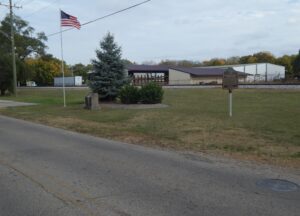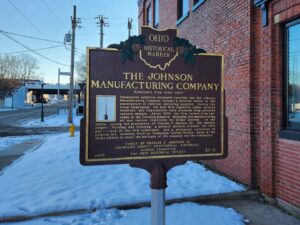, OH
Ada grew alongside the tracks of the Ohio & Indiana Railroad, completed in 1854 between Crestline, Crawford County, and Fort Wayne, Indiana. This line became part of the Southwest Division of the Pennsylvania Railroad in 1869. Ada’s rapid growth as a college town in the 1880s prompted the railroad to build this distinctive and unique two-story Stick Style depot in 1887, departing from the railroad’s standard depot plans. Larger than most small-town stations, it features a second-story telegrapher’s office. For many years the station served as Ada’s gateway to the outside world. One of few surviving 19th century Pennsylvania passenger stations in Ohio, the Ada depot was added to the National Register of Historic Places in 1998.
, OH
The freight depot east of this marker stands on the western terminus of Hancock County’s first rail link to the outside world. In 1849 the Mad River and Lake Erie Railroad Company opened a branch line from Findlay to its main line at Carey. A freight warehouse was built here ca. 1848 and passenger station in 1863. The Cleveland, Cincinnati, Chicago, and St. Louis Railroad replaced these earlier buildings with the present depot in the 1890s.
, OH
Known as the “Halfway House,” the Gooding House and Tavern was built by George B. Gooding halfway between the towns of Worthington and Delaware in 1827. Its location was influenced by construction of the Columbus and Sandusky Turnpike that was chartered by the State of Ohio the year before. Also known as the “Mud Pike,” the turnpike was slow and difficult for travelers and could take nearly a day to travel 10 miles. The Gooding House was the perfect place for stagecoach drivers to change teams of horses and for travelers to rest and have refreshments. George Gooding also prospered as a farmer with over 1,000 acres of land. This stately brick farmstead remained in the Gooding family for 175 years with each succeeding generation adding its imprint on the property. The Gooding House and Tavern was listed on the National Register of Historic Places in 2005 and restored in 2007.
, OH
The original town plat of Rawson was filed on February 3, 1855, consisting of fifty-five lots in sections 13 and 14 of Union Township, Hancock County on the Frederick Keller and George J. Kelly farms. Several residential and business structures were built in anticipation of completion of a railroad rumored to pass from Fremont through the “Rawson” area on its way to the western boundary of Ohio. Farmers Keller and Kelly named their village Rawson after L.Q. Rawson, President of the railroad company, hoping that the name would encourage him to build through their area. Financial troubles delayed construction causing a standstill in Rawson. Seventeen years later the first locomotive arrived in Rawson, spurring new construction. At that time the railroad was called the Lake Erie and Louisville; in 1879 it was changed to the Lake Erie and Western and in 1922 became part of the Nickel Plate Railroad. (Continued on other side)
, OH
Carlisle Station Depot. The Carlisle depot for the Cincinnati, Hamilton & Dayton (CH&D) railroad was located nearby. The CH&D started operations in 1851 and was the second railroad through Warren County. Carlisle Station was a passenger and freight-shipping depot and was joined in 1872 by another, when Cincinnati & Springfield Railroad (later part of the Big Four and the New York Central Railroads) erected a depot in nearby Franklin. Carlisle was originally known as the “Jersey Settlement,” because many settlers in the early 1800s were from New Jersey. George Carlisle, vice-president of the CH&D, purchased a large tract of land here. After Carlisle and his wife Sarah donated a lot to the community in 1856, residents renamed the place “Carlisle Station.” The Carlisle Literary Association built a hall on the lot c. 1856, which, as of 2019, remains as the older section of Carlisle’s municipal building. Side B: Schenck-Stanton Rally, October 3, 1868.
, OH
The Bradford or “BF” Tower was built by the Pennsylvania Railroad circa 1929, at the important site of Bradford Junction. It replaced an earlier wooden tower that stood to its west. From this building, operators controlled the movement of every train, aligned track switches, set the track side signals, and relayed messages to the crews in the locomotive and caboose of passing trains. The tower originally housed a desk, telegraph equipment, and the all-important railroad clock. Its core housed many steel throw-arms, known as Armstrong levers. These were hand thrown, connecting track switches and signals via pipes throughout the junction area. The operator telegraphed other outlying towers and dispatching centers in Columbus, Ohio and Indianapolis and Logansport, Indiana. Railroad telephones appeared during the late 1920s and radios just after World War II. The tower was closed January 3, 1984. This is an example of the once common railroad interlocking tower that dotted railroads throughout Ohio and the United States.
, OH
The Johnson Manufacturing Company was incorporated in 1902 by brothers James B., J. Will, Isaac T., and Charles F. Johnson, all of Quaker heritage. The company manufactured tin and galvanized iron ware for railroad lines across the United States. The initial product was the No. 1 long-spouted locomotive oiler with the patented dripless spout. That was quickly followed by other types of oil cans, signaling equipment, engine buckets, tallow pots, torches, track inspection devices, tin cups, and caboose and cabin car lamps, all carrying the Diamond J trademark. The makers created the patterns and everything was cut, riveted, and soldered by hand. As production expanded, the original frame building at 605 Miami Street was replaced by a brick structure in 1910, the southernmost part of the present building. (continued on other side)
, OH
The coming of the railroads to Alliance is an important event in Stark County’s history. In 1851, the Cleveland & Pittsburgh Railroad (running SE to NW) and the Ohio & Pennsylvania Railroad (E to W) intersected at this location. It was known as “the crossing” and became the Village of Alliance. William Robinson, Jr., the president of the Ohio & Pennsylvania Railroad, is credited with applying the name “Alliance” to the crossing, dating to when the railroads bought rights-of-way in 1849 and anticipated the intersection of the lines. A plat named “Alliance” was recorded September 26, 1850. The Village of Alliance was established in 1854, when 100 citizens of the communities of Williamsport, Freedom, and Alliance (also known as Liberty), signed a petition to incorporate on March 15. The petition was accepted and recorded in June.









